“Searching for the Soul of Service Stations” 26.11.2021-05.02.2022
October 3, 2021 4:13 pm“Searching for the Soul of Service Stations”
From boring to a lively, almost sexy subject
November 26th, 2021 – February 5th, 2022
Update January 2023:
Book Project //Boek project:
Due to the success of the exhibition, we are currently working on the making of a book entitled “Searching for the Soul of Service Stations”. A crowdfunding campaign has been initiated to allow finance (part of) the costs of printing and publishing of te book. In case you are interested and willing to support the project by placing a pre-order or simply making a donation, please click on the link hereunder:
**********
“Searching for the Soul of Service Stations”
This exhibition offers a non-exhaustive look at Service-Stations highlighting their different aspects, past, present and future (do they actually have any future?), through a collection of photos and paintings in our private collection, gathered over the years. A cocktail of nostalgia, history, aesthetics, romanticism, social aspects, business, realism, and a pinch of humour. A tentative attempt to uncover the soul of the service-station, transforming a rather dull subject into a lively, creative almost sexy one.
With works by: Hedy Betschart, Jaap Bijsterbosch, Harrie Blommesteijn, Birgitt Busz, Valentin Brindesi, Eric Chan, Jessie Chaney, Cheri-Cherin, Matt Dunlap, Odile Gesse, Araun Gordijn, Dutch den Hollander, Jacques Meijer, Wanda Michalak, Simon Nicoloso, Adrienne M. Norman, Chris Olszewski, Jorgen Polman, Paul Schaublin, Thomas Schlijper, Tomek Sikora, Nico vd Stam, Marek Stawski, Michiel Voet & Jeroen Bisscheroux, WitkowskaVerbunt, Krzysztof Wojciechowski, Marion Post Wolcott
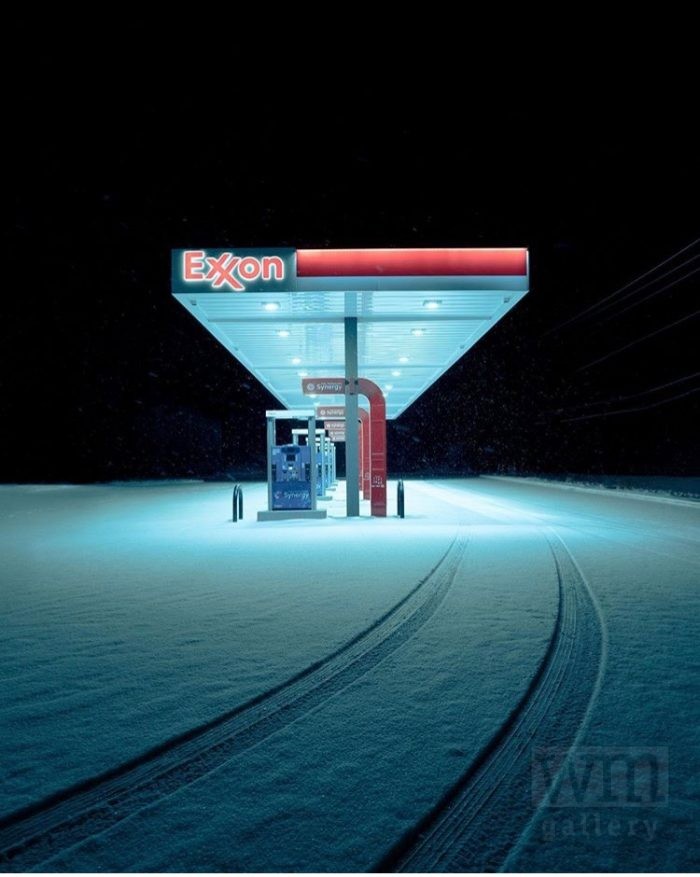
South Bend, Indiana (USA) 2020 © Matt Dunlap
Ugly Non-Places
Many consider the contemporary service-station as a necessary evil: let’s be honest; they are generally ugly, occupy a lot of space, and are considered to be the symbol of the destructive use of fossil fuel, obviously harmful to the environment. Some might define them as “non-places”, much like motorways, hotel rooms, airports or shopping malls. The term “non-place” was coined by French anthropologist Marc Augé. In his book “Non-Lieux. Introduction à une anthropologie de la surmodernité” Augé refers to spaces of transience where human beings remain anonymous. These spaces do not hold enough significance to be regarded as “places” in their anthropological definition, that is, places that offer the possibility of a shared referentiality and that can empower common identities. Nevertheless, these establishments have become a ubiquitous part of our environment. Any vehicle user, whether owner, driver, or simple passenger depends on them completely, willingly or not. These places of public utility are inherent to our daily life and means of auto-mobility.
Nostalgia
Historically, service stations, petrol pumps or gas garages have been around for more than a century around the globe and consequently, many older stations have become the stuff of nostalgia, romanticism or even history. Many of them are now abandoned, falling apart, or refashioned for other purposes. They now reflect a certain charm, symbols of another time, of a more optimistic, hyper-capitalist time even, when the aspiration to own a car was second only to that of owning one’s own house. For some, nowadays, an abandoned service station along the road is simply a symbol of a decadent capitalistic society on its way out.
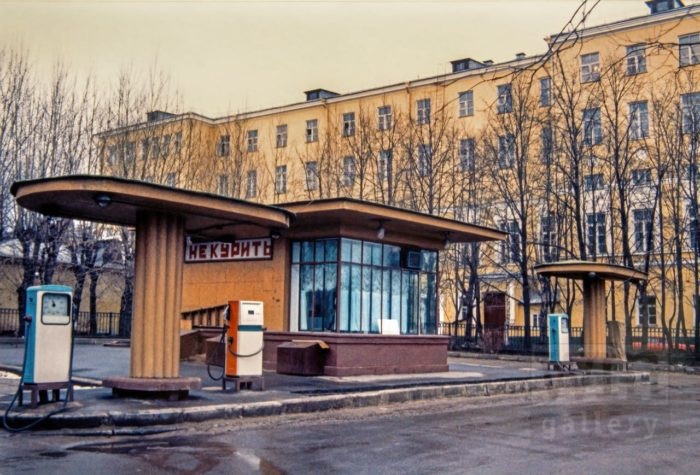
Moscow 1990 © Paul Schaublin
The Very Social
Although we may hate to admit it, there is also a very social aspect to service stations. Gas stations are hardly ever considered to be social spaces. However gas stations, as well as other kerbside artefacts, abound in social life. People use them as meeting points, resting places, mini markets, coffee shops, sandwich bars and use services such as car washes. People continuously cross each other and interact. The smile of the cashier can be refreshing (in the old times it was the smile of the attendant at the pump) or even flirtatious.
This social role has evolved in the last decades with the expansion of shops into supermarkets and restaurants. In some cases, the service station is only one element, integrated into what has become a shopping mall complex along the highway. There also are special cases, like the one in Dinteloord (Brabant) which has integrated a library, open 7 days a week. A great public service!
Relative precarity
Service Stations usually have a short lifespan. They must constantly be renovated, refurbished, upgraded to remain competitive. In the Netherlands the lifespan of functional constructions is generally calculated to be 7-10 years. Regular renovations are required to maintain competitiveness (new pumps, bigger shop, new look, etc..). Filling stations that have lost their competitiveness are either removed or, in some cases, simply abandoned.
Also, changes in laws due to urban redevelopments or new environmental requirements may dictate the destiny of service stations, triggering a relocation or even an elimination, especially in city centres. The latter is quite evident in Amsterdam where the amount of assets has drastically diminished in the past decades. Standalone urban service stations are slowly disappearing, others are redeveloped along highways or integrated into large shopping centres.
Some service stations have embarked on a new life, like this one in Amsterdam Noord which has become an art & event venue. Even more ironic perhaps is a station near Martigny, Switzerland which became a roadside sex club (since closed as well).
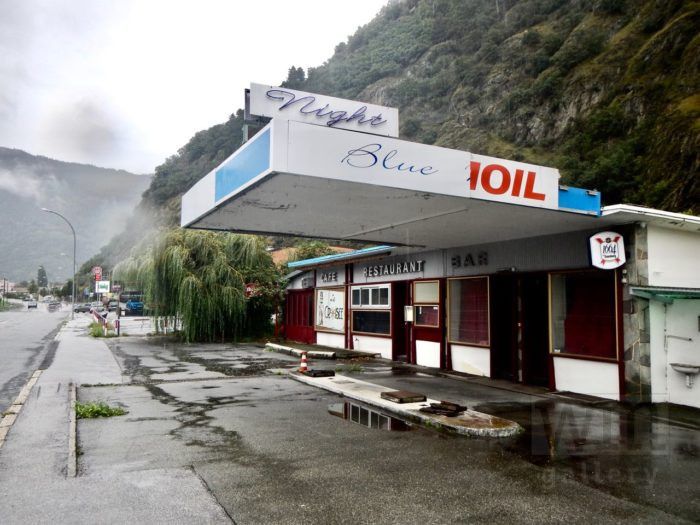
Martigny, Switzerland 2021 © Paul Schaublin
Endangered species?
Will the boom of the electrical car ring the bell for the filling stations? Online energy delivery is becoming a reality. Charging stations are available not only in service stations and restaurants along the highways but also in shopping centres, parking places, community centres and even private houses. Will the spread of electric car charging stations over the city make the need for specific filling stations redundant? There was recently the mention of a law passed in the Californian city of Petulama, prohibiting the building, renovating or relocating of new or existing service stations. Will this become a new trend?
What has become undeniably obvious is that the peak of service station construction, globally, was from the 1960s up until the early 1990s. Since then, their decline has become inexorable.
Are Service Stations as we know them endangered species? Will the next generations consider them as historical curiosities, fossils from the age of fossil fuels? If so, we might want to contemplate the totality of this exhibition as one big nostalgic piece, an ode to the once ubiquitous service-station.

Marivale, Queensland (Australia) 2021 photo © Chris Olszewski
***********************************************************************************************************
Op Zoek naar de Ziel van Tankstations
Van saai naar een levendig, bijna sexy onderwerp
26 november 2021- 5 februari 2022
De tentoonstelling is vrij toegankelijk zonder reservering
Open elke week woensdag t/m zaterdag 13:00 – 18:00 uur
De tentoonstelling wordt verlengd t/m zaterdag 5 februari, 2022
*************
Op Zoek naar de Ziel van Tankstations
Deze tentoonstelling biedt een eclectische blik op Tankstations en belicht hun verschillende aspecten, verleden, heden en toekomst (hebben ze eigenlijk wel een toekomst?), door middel van een verzameling foto’s en schilderijen in onze privécollectie, verzameld door de jaren heen. Een cocktail van nostalgie, geschiedenis, esthetiek, romantiek, sociale aspecten, economie, realisme en een snufje humor. Een voorzichtige poging om de ziel van het tankstation bloot te leggen, waarbij een nogal saai onderwerp wordt omgevormd tot een levendig, creatief, bijna sexy onderwerp.
Lelijke non-plaatsen
Velen beschouwen de hedendaagse tankstation als een noodzakelijk kwaad: laten we eerlijk zijn; ze zijn over het algemeen ook lelijk, nemen veel ruimte in beslag en worden beschouwd als het symbool van het destructieve gebruik van fossiele brandstoffen die uiteraard schade berokkenen in het milieu. Sommigen zouden ze definiëren als “non-plaatsen”, net zoals snelwegen, hotelkamers, luchthavens of winkelcentra. De term “non-plaats” werd bedacht door de Franse antropoloog Marc Augé. In zijn studie “Non-Lieux. Introduction à une anthropologie de la surmodernité” verwijst Augé naar ruimten van doorgang, waar mensen kortdurend verblijven en anoniem blijven. Deze ruimten hebben niet genoeg betekenis om te worden beschouwd als “plaatsen” in enig antropologische zin, dat wil zeggen plaatsen die een gedeelde referentialiteit kunnen bieden en gemeenschappelijke identiteiten kunnen versterken. Niettemin zijn deze etablissementen een alomtegenwoordig onderdeel van onze omgeving geworden. Elke voertuiggebruiker, eigenaar, bestuurder of eenvoudige passagier is volledig afhankelijk van hen, vrijwillig of niet. Deze plaatsen van openbaar nut zijn inherent aan ons dagelijks leven en auto-mobiliteit.
Nostalgie
Historisch gezien bestaan tankstations, benzinepompen of gasgarages al meer dan een eeuw over de hele wereld en als gevolg daarvan zijn veel oudere stations verworden tot nostalgie, romantiek of zelfs geschiedenis. Velen van hen zijn nu verlaten, vallen uit elkaar of zijn omgevormd voor andere doeleinden. Ze weerspiegelen nu een zekere charme, symbolen van een andere tijd, misschien wel van een meer optimistische, hyperkapitalistische tijd zelfs, toen het streven om een auto te bezitten bijna net zo belangrijk werd geacht als het bezit van een eigen huis. Tegenwoordig is voor sommigen een verlaten tankstation langs de weg gewoon een symbool van een decadente kapitalistische samenleving die op zijn retour is.
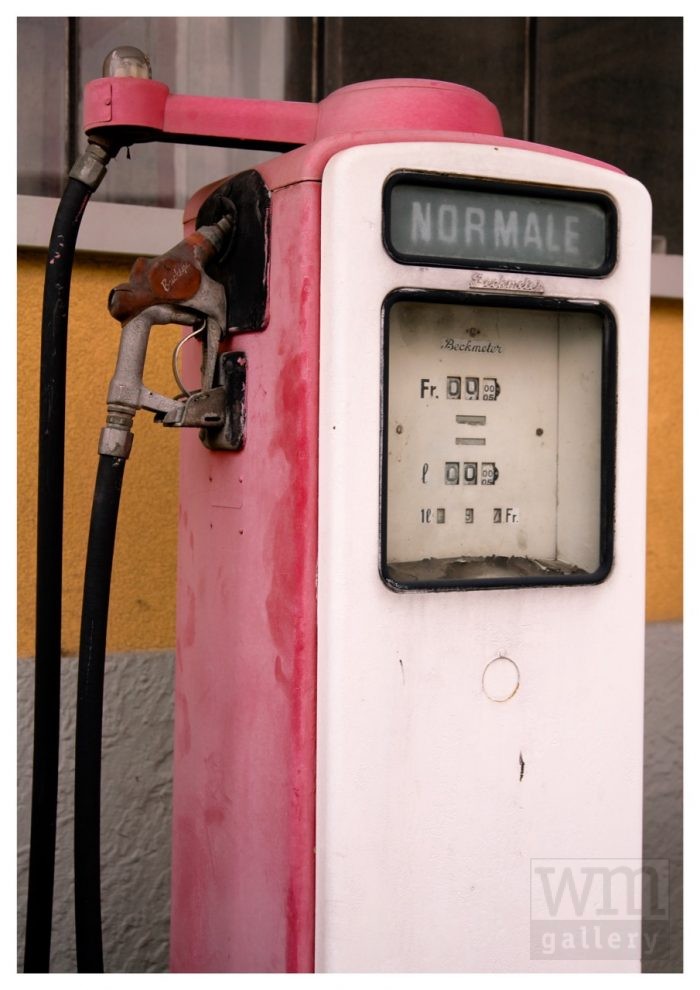
Martigny, Zwitserland photo © Valentin Brindesi
Het zeer sociale
Hoewel we het misschien niet graag toegeven, hebben tankstations ook een heel sociaal aspect. Benzinestations worden bijna nooit beschouwd als sociale ruimtes. Maar benzinestations, evenals andere artefacten langs de weg, zijn in overvloed aanwezig in het sociale leven. Mensen gebruiken ze als ontmoetingsplaatsen, rustplaatsen, supermarktjes, koffiepunten, broodjeszaken en maken gebruik van diensten zoals autowasstraten. Mensen kruisen elkaar voortdurend en hebben interactie met elkaar. De glimlach van de kassamedewerker kan verfrissend zijn (vroeger was dat de glimlach van de pompbediende) of, in sommige gevallen, zelfs flirterig.
Deze maatschappelijke rol is in de afgelopen decennia geëvolueerd met de uitbreiding van winkels naar supermarkten en restaurants. In sommige gevallen is het tankstation slechts één onderdeel, geïntegreerd in wat een winkelcentrumcomplex langs de snelweg is geworden. Er zijn ook speciale gevallen, zoals die in Dinteloord (Brabant) waar een bibliotheek is geïntegreerd, die 7 dagen per week geopend is. Een geweldige openbare dienst!
Relatieve onzekerheid
Tankstations hebben doorgaans een korte levensduur. Ze moeten voortdurend worden gerenoveerd, opgeknapt en geüpgrade om concurrerend te blijven. In Nederland wordt de levensduur van functionele constructies over het algemeen berekend op 7-10 jaar. Regelmatige renovaties zijn nodig om het concurrentievermogen te behouden (nieuwe pompen, grotere winkel, nieuwe look, enz..). Benzinestations die hun concurrentievermogen hebben verloren, worden al snel opgedoekd of in sommige gevallen gewoon verlaten.
Ook kunnen wetswijzigingen als gevolg van stedelijke herontwikkelingen of nieuwe milieueisen het lot van tankstations dicteren, wat kan leiden tot een verhuizing of zelfs een eliminatie, vooral in stadscentra. Dat laatste is duidelijk zichtbaar in Amsterdam, waar de hoeveelheid benzinestations de afgelopen decennia drastisch is afgenomen. Op zichzelf staande stedelijke tankstations verdwijnen langzaam, andere worden herontwikkeld langs snelwegen of geïntegreerd in grote winkelcentra.
Sommige tankstations zijn aan een nieuw leven begonnen, zoals deze in Amsterdam Noord die een kunst- en evenementenlocatie is geworden. Nog ironischer misschien is een station in de buurt van Martigny, Zwitserland, dat een seksclub langs de weg werd (sindsdien ook gesloten).

“Paul’s Dream” Oude Leeuwarderweg WZ, Amsterdam-Noord, 2021 © Harrie Blommesteijn
Bedreigde soort?
Zal de hausse van de elektrische auto de bel rinkelen voor de tankstation? Online energielevering wordt een realiteit. Laadstations zijn er niet alleen in tankstations en restaurants langs de weg, maar ook in winkelcentra, parkeerplaatsen, buurthuizen en zelfs particuliere huizen. Zal de spreiding van laadpalen voor elektrische auto’s over de stad de behoefte aan specifieke tankstations overbodig maken? Onlangs was er sprake van een wet die werd aangenomen in de Californische stad Petulama, die het bouwen, renoveren of verplaatsen van nieuwe of bestaande tankstations verbiedt. Wordt dit een nieuwe trend?
Wat onmiskenbaar duidelijk is geworden, is dat het hoogtepunt van de bouw van tankstations, wereldwijd, lag vanaf de jaren zestig tot het begin van de jaren negentig. Sindsdien is hun achteruitgang overduidelijk geworden.
Zijn tankstations zoals wij die kennen een bedreigde diersoort? Zullen de volgende generaties ze beschouwen als historische curiositeiten, fossielen uit het tijdperk van fossiele brandstofgebruik? Als dat zo is, kunnen we de totaliteit van deze tentoonstelling misschien beschouwen als één groot nostalgisch stuk, een ode aan de ooit alomtegenwoordige tankstation.
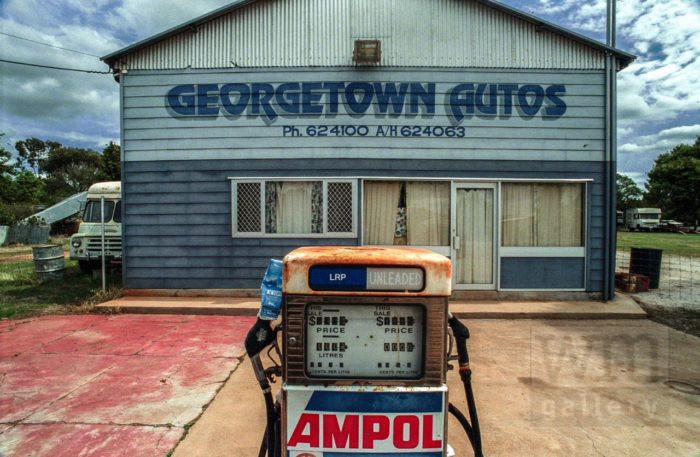
Australia Outback 2003 photo © Tomek Sikora
***********************************************************************************************************************
Opening speech bij Jaap Bijsterbosch (in Dutch)
Lieve mensen,
het is ook een beetje mijn schuld dat al deze foto’s hier vandaag te bewonderen zijn. Zo’n 20 jaar geleden had ik hier een tentoonstelling met nachtfoto’s. De 4-e tentoonstelling ooit in de Gallery. Paul viel voor de foto van het tankstation uit Abcoude. Hij vertelde dat hij afbeeldingen van tankstations verzamelde. Dat moet je laten zien in de galerie zei ik. Na ruim 20 jaar zien we vandaag een deel van die verzameling van tankstations van over de hele wereld.
Of servicestations zoals Paul ze noemt en waarmee hij aangeeft dat tankstations voor hem meer zijn dan alleen een plek waar je brandstof koopt voor je auto. Het is 1 van de dingen die hij zichtbaar wil maken in de expositie vandaag. Hoe het tankstation evalueerde van eenvoudige pomp naast de garage tot een onderdeel van een soort ontmoetingscentrum voor chauffeurs, en hoe tankstations soms ophielden te bestaan als benzinepomp en veranderden in jeugdcentra, opslagruimtes en soms zelfs in een soort bordeel. Die verschillende functionaliteit is 1 van de thema’s van de expo.
Ooit zei Henri Cartier-Bresson: Een goede foto wordt gemaakt als Hart, Oog en Hoofd samenvallen. Hart als in hart voor de zaak, Oog voor de heldere blik en hoofd voor het samenhangend verhaal achter de foto. Hij mompelde ook nog iets over een beslissend moment, maar dat oog, dat hart, dat hoofd in die goede foto, zou dat ook opgaan voor een verzameling foto’s? Een verzameling zoals vandaag .Foto’s en een enkel schilderij die elk min of meer als onderwerp het tankstation hebben?
Het hart dus. Paul heeft jaren in de business van tankstations gewerkt. Als je met hem daarover spreekt over die tijd glinsteren zijn ogen. Tankstations, servicestations hebben toen zijn hart gestolen.
Vandaag op de tentoonstelling hangt ook een echte Schaublin. Daarmee bedoel ik niet een foto, die hangen er trouwens ook, foto’s door Paul zelf gemaakt . Nee, met een Echte Schaublin bedoel ik een tankservicestation bedacht, ontworpen, geproduceerd door Paul zelf. Het staat in Amsterdam-Noord. Je kunt het vandaag zien op de foto van Harrie Blommestein.
Het oog dan. Het oog van Paul is vandaag aanwezig, zowel het verzamelaarsoog als het oog van Paul de fotograaf. Allereerst het oog van de fotograaf. Alhoewel misschien bedoeld als toevallige snapshots vind ik de foto’s die Paul zelf gemaakt uiterst helder en sfeervol. Een van de meest sfeervolle foto’s op de expositie is het beeld van een tankstation in Moskou van voor de perestrojka. Een immens treurige plek, kale bomen voor een Sovjethuurkazerne in een natte stad.
Gefotografeerd zonder opsmuk als een toevallig snapshot en mede dankzij de digitale techniek van zowel Pete Purnell en als van Dutch den Hollander omgetoverd tot een pronkstuk van de expositie.
Het oog van Paul de verzamelaar. Als je erin slaagt om zoveel soorten beelden van tankstations bij elkaar te vinden, van de onscherpe lichtjes van Harrie tot de opengesneden benzinepomp aan het begin en je dat doet via bijvoorbeeld een nostalgische foto uit familiealbum met een T-Ford als modern transportmiddel naast een paard en wagen dan heb je een goed oog als verzamelaar.
Ook aanwezig vandaag : het hoofd van Paul, verantwoordelijk voor de samenhang in de expositie. Gelukkig voor Paul was hier zijn hoofd niet alleen, het hoofd van Sebastian, met ook die zijn oog en hart, kwam erbij. Samen bezorgt die samenwerking tussen de ogen, harten en hoofden van die twee ons in de galerie een sprookje van mooie, spannende samenhangende beelden. Het portret door Dutch van de eigenaar van het tankstation in Syrië, poserend samen met broer of neef en het trotse zoontje, het romantische nachtbeeld aan de weg bij Gent van Jacques Meijer, die aan Paul vertelde dat in het belendende café een groepje dames met een bepaalde bijverdienste samenzat, het tankstation aan de rand van de woestijn wat bij mij het eeuwige on-the-road-again gevoel boven bracht, wat ik had als ik als lifter op zulke tankstations op de volgende lift wachtte.
En dan die prachtige foto in de etalage. Wonderlijk beeld. Met het enkele eindige bandenspoor in de sneeuw als surrealistisch raadsel.
Zo zijn er heel veel beelden vandaag die een kijker raken en nieuwsgierig maken.
Nooit geweten dat zo’n prozaïsch onderwerp zo’n prachtige poëtische tentoonstelling oplevert. En dat, lieve mensen is te danken aan de fotografen en beeldmakers, maar ook en vooral aan de harten, de ogen en de hoofden van Paul & Sebastian.
Gefeliciteerd mannen, met deze prachtige tentoonstelling!
Diemen/Amsterdam, 26/11.2021, Jaap Bijsterbosch.
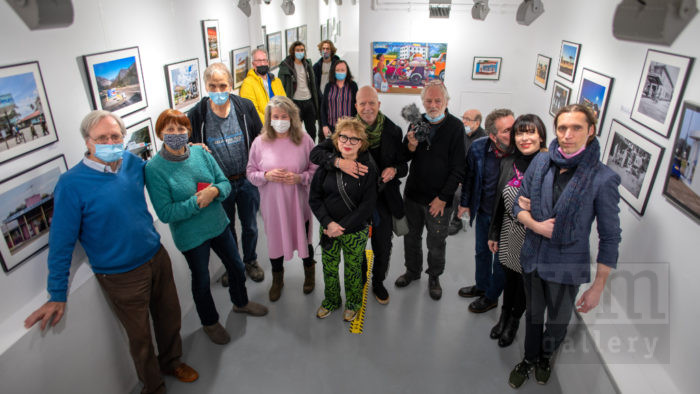
26 November 2021, Paul Schaublin together with part of the artists who were present at the opening. First row from left to right: Paul Schaublin, Wanda Michalak, Jaap Bijsterbosch, Adrienne Norman, Birgitt Busz, Harrie Blommesteijn, Dutch den Hollander, Marek Stawski, Anna Witkowska en Rob Verbunt. Photo © Pete Purnell
Opening speech (English translation)
Dear all,
It is also somewhat my fault that all these photos can be admired here today. About 20 years ago I had an exhibition here with night photos. The 4th exhibition ever at the Gallery. Paul fell in love with the photo of the gas station from Abcoude. He said he collected pictures of gas stations. “ You have to show that in the gallery” , I said. After more than 20 years, today we see part of that collection of gas stations from all over the world.
Or service stations as Paul calls them, indicating that, to him, gas stations are more than just a place to buy fuel for your car. It is one of the things he wants to make visible in the exhibition today. How the gas station evolved from a simple pump next to the garage to a part of a kind of meeting centre for drivers, and how gas stations sometimes ceased to exist as a gas pump and turned into youth centres, storage rooms and sometimes even into a kind of brothel. This different functionality is one of the themes of the expo.
Henri Cartier-Bresson once said: A good photo is made when Heart, Eye and Head coincide. Heart as in heart for the cause, Eye for the clear view and Head for the coherent story behind the photo. He also mumbled something about a defining moment, but that eye, that heart, that head in that good photo; would that hold true for a collection of photos as well? A collection like what we see today. Photos and a painting, all of them more or less with the service station as subject matter?
So, let’s start with the heart. Paul has worked in the service station business for years. When you talk to him about that time, his eyes sparkle. Gas stations, service stations stole his heart then.
Today in the exhibition there is also an authentic Schäublin. By that I do not mean a photo, although they are also hanging here, photos taken by Paul himself. No, by a Genuine Schaublin I mean a service station conceived, designed, produced by Paul himself. It is located in Amsterdam North. You can see it today in Harrie Blommestein’s photo.
The eye then. The eye of Paul is present today, both the collector’s eye and the eye of Paul the photographer. First of all, the eye of the photographer. Although perhaps intended as accidental snapshots, I find the photos that Paul himself made extremely clear and atmospheric. One of the most atmospheric photos in the exhibition is the image of a gas station in Moscow before perestroika. An immensely sad place, bare trees in front of a Soviet tenement in a wet city.
Straightforwardly photographed as a casual snapshot, and thanks to the digital technology of both Pete Purnell and Dutch den Hollander, it has been transformed into a showpiece of the exhibition.
The eye of Paul the collector. If you manage to put together so many types of images of gas stations; from Harrie’s out-of-focus lights to the cut-open gas pump at the beginning of the exhibition, and you do so via, for example, a nostalgic photo from a family album with a Model T-Ford as a modern means of transport next to a horse and carriage, then yes, you have a good eye as a collector.
Also present today: the head of Paul, responsible for the coherence of the exhibition. Fortunately for Paul, his head wasn’t alone here, Sebastian’s head, along with his eye and heart, was added. Together, this collaboration between the eyes, hearts and minds of those two gives us in the gallery a fairy tale of beautiful, exciting coherent images. The portrait by Dutch of the owner of the gas station in Syria, posing together with brother or cousin and proud son. The romantic night scene on the road near Ghent by Jacques Meijer, who told Paul that in the adjacent café a group of ladies with a certain extra income. The gas station on the edge of the desert which brought out the eternal on-the-road-again feeling I had when waiting for my next ride as a hitchhiker at such gas stations.
And then that beautiful photo in the gallery window. Wonderful image. With the single finite tire track in the snow as a surreal riddle.
There are many images today that touch the viewer and make them curious.
Never knew that such a prosaic subject yields such a beautiful poetic exhibition. And that, dear people, is thanks to the photographers and image makers, but also and especially to the hearts, eyes and heads of Paul & Sebastian.
Congratulations guys, with this beautiful exhibition!
Jaap Bijsterbosch
Media
If There is Now, Walter van Teeffelen 10.12.2021 (blog post):
- Dutch version: Met Paul Schaublin op zoek naar de ziel van het tankstation
- English version: With Paul Schaublin Searching for the Soul of Service Stations
Het Parool, Jan Pieter Ekker:
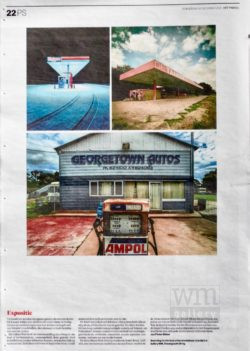
Het Parool 16.12.2021
Tankstations worden doorgaans gezien als een noodzakelijke kwaad: lelijke non-plekken die veel ruimte in beslag negenen symbool staan voor het destructieve gebruik van fossiele brandstoffen, die uiteraard schade berokken aan het milieu.
Bij Gallery WM biedt de tentoonstelling “Searching for the Soul of Service Stations”, samengesteld door galeries Paul Schaublin en curator Sebastian Rypson, een andere kijk op tankstations. Ze blijken vol leven en hypnotiserend, vrolijk stemmend en zelfs een beetje sexy.
De foto’s (en enkele schilderijen) zijn grotendeels afkomstig uit de privecollectie van de galerist. Er zitten werken bij van jonge talenten en gevestigde namen, uit binnen-en buitenland. Samen vormen ze een cocktail van nostalgie, geschiedenis, esthetiek, rondtik, sociale aspecten, economie, realisme en een snufje humeur.
De Amerikaan Matt Dunlap maakte in South Bend, Indiana, een betoverende nachtfoto van een Exxon-station in de verse sneeuw. De Pool Tomek Sikora fotografeerde een pomp ver van de bewoonde wereld in kurkdroog Australie. Wat dichterbij maakte Harrie Blommesteijn een foto van de (roze) Tanker, een oud pompstation in het Noorderpark waarin nu een culturele studio annex vrijhaven huist. – Jan Pieter Ekker 16.12.2021
*******************
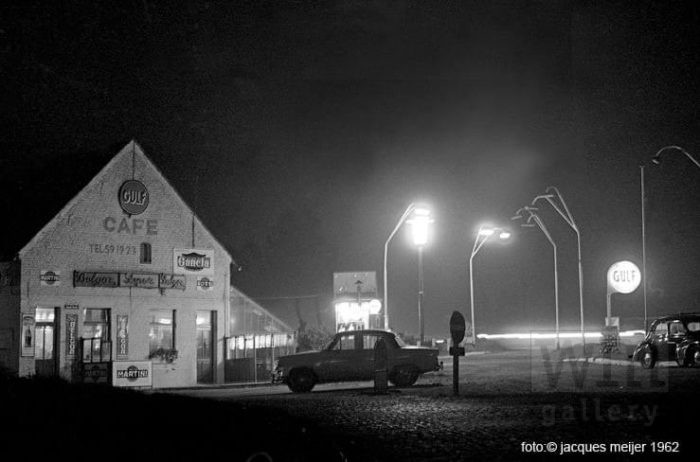
On the road, between Antwerp and Ghent (Belgium) 1962 © Jacques Meijer

Frameries (Belgium) 1986. During the opening of a new gas station © Paul Schaublin
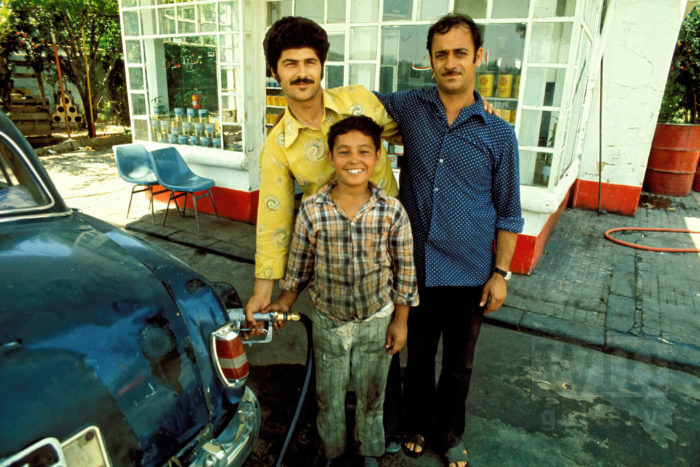
Aleppo (Syrie) 1975 © Dutch den Hollander
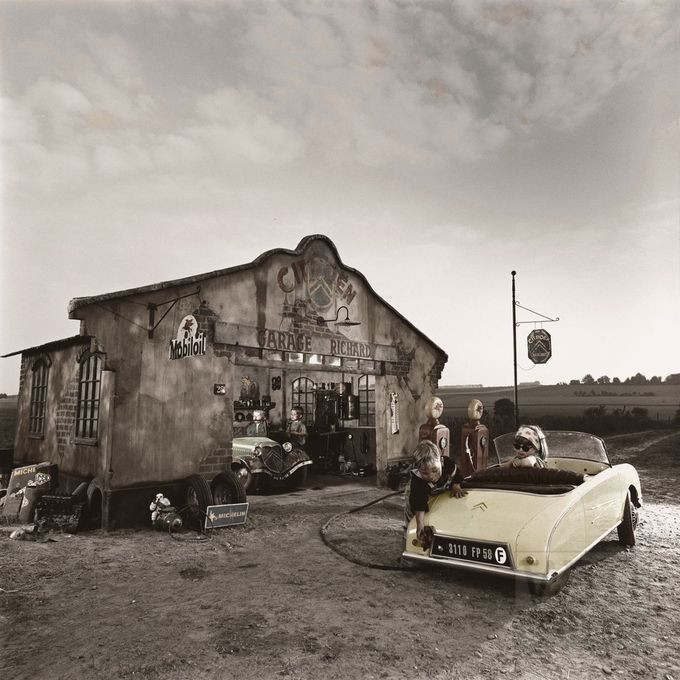
Kinderdromen 2000 © Jorgen Polman

“Twee wachtenden voor u” 1999 schilderwerk © Araun Gordijn
Tags: Adrienne M Norman, Anna Witkowska, Araun Gordijn, Birgitt Busz, Cheri-Cherin, Chris Olszewski, Dutch den Hollander, Eric Chan, Harrie Blommesteijn, hedy beschart, Jaap Bijsterbosch, Jacques Meijer, Jessie Chaney, Jorgen Polman, Krzysztof Wojciechowski, Marek Stawski, Matt Dunlap, Nico van der Stam, Paul Schäublin, Rob Verbunt, simon nicolas, Thomas Schlijper, Tomek Sikora, Valentin Brindesi, Wanda Michalak
